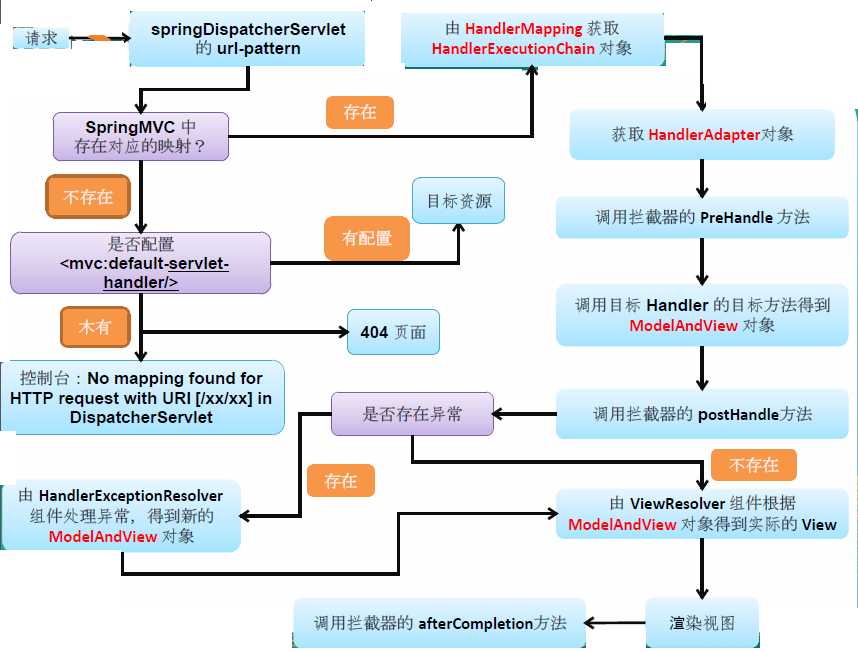标签:
<!--configure the setting of springmvcDispatcherServlet and configure the mapping--> <servlet> <servlet-name>springmvc</servlet-name> <servlet-class>org.springframework.web.servlet.DispatcherServlet</servlet-class> <init-param> <param-name>contextConfigLocation</param-name> <param-value>classpath:springmvc-servlet.xml</param-value> </init-param> <!-- <load-on-startup>1</load-on-startup> --> </servlet> <servlet-mapping> <servlet-name>springmvc</servlet-name> <url-pattern>/</url-pattern> </servlet-mapping>
<?xml version="1.0" encoding="UTF-8"?> <beans xmlns="http://www.springframework.org/schema/beans" xmlns:xsi="http://www.w3.org/2001/XMLSchema-instance" xmlns:context="http://www.springframework.org/schema/context" xmlns:mvc="http://www.springframework.org/schema/mvc" xsi:schemaLocation="http://www.springframework.org/schema/beans http://www.springframework.org/schema/beans/spring-beans.xsd http://www.springframework.org/schema/context http://www.springframework.org/schema/context/spring-context-4.1.xsd http://www.springframework.org/schema/mvc http://www.springframework.org/schema/mvc/spring-mvc-4.1.xsd"> <!-- scan the package and the sub package --> <context:component-scan base-package="test.SpringMVC"/> <!-- don‘t handle the static resource --> <mvc:default-servlet-handler /> <!-- if you use annotation you must configure following setting --> <mvc:annotation-driven /> <!-- configure the InternalResourceViewResolver --> <bean class="org.springframework.web.servlet.view.InternalResourceViewResolver" id="internalResourceViewResolver"> <!-- 前缀 --> <property name="prefix" value="/WEB-INF/jsp/" /> <!-- 后缀 --> <property name="suffix" value=".jsp" /> </bean> </beans>
1.需要导入两个jar包

2.在SpringMVC配置文件中加入
<!-- upload settings --> <bean id="multipartResolver" class="org.springframework.web.multipart.commons.CommonsMultipartResolver"> <property name="maxUploadSize" value="102400000"></property> </bean>
3.方法代码
@RequestMapping(value="/upload",method=RequestMethod.POST) public String upload(HttpServletRequest req) throws Exception{ MultipartHttpServletRequest mreq = (MultipartHttpServletRequest)req; MultipartFile file = mreq.getFile("file"); String fileName = file.getOriginalFilename(); SimpleDateFormat sdf = new SimpleDateFormat("yyyyMMddHHmmss"); FileOutputStream fos = new FileOutputStream(req.getSession().getServletContext().getRealPath("/")+ "upload/"+sdf.format(new Date())+fileName.substring(fileName.lastIndexOf(‘.‘))); fos.write(file.getBytes()); fos.flush(); fos.close(); return "hello"; }
4.前台form表单
<form action="mvc/upload" method="post" enctype="multipart/form-data"> <input type="file" name="file"><br> <input type="submit" value="submit"> </form>
1.创建一个MyInterceptor类,并实现HandlerInterceptor接口
public class MyInterceptor implements HandlerInterceptor { @Override public void afterCompletion(HttpServletRequest arg0, HttpServletResponse arg1, Object arg2, Exception arg3) throws Exception { System.out.println("afterCompletion"); } @Override public void postHandle(HttpServletRequest arg0, HttpServletResponse arg1, Object arg2, ModelAndView arg3) throws Exception { System.out.println("postHandle"); } @Override public boolean preHandle(HttpServletRequest arg0, HttpServletResponse arg1, Object arg2) throws Exception { System.out.println("preHandle"); return true; } }
2.在SpringMVC的配置文件中配置
<!-- interceptor setting --> <mvc:interceptors> <mvc:interceptor> <mvc:mapping path="/mvc/**"/> <bean class="test.SpringMVC.Interceptor.MyInterceptor"></bean> </mvc:interceptor> </mvc:interceptors>
3.拦截器执行顺序

1.创建一个test.SpringMVC.integrate的包用来演示整合,并创建各类

2.User实体类
public class User { public int getId() { return id; } public void setId(int id) { this.id = id; } public String getName() { return name; } public void setName(String name) { this.name = name; } public Date getBirth() { return birth; } public void setBirth(Date birth) { this.birth = birth; } @Override public String toString() { return "User [id=" + id + ", name=" + name + ", birth=" + birth + "]"; } private int id; @NotEmpty private String name; @Past @DateTimeFormat(pattern="yyyy-MM-dd") private Date birth; }
3.UserService类
@Component public class UserService { public UserService(){ System.out.println("UserService Constructor...\n\n\n\n\n\n"); } public void save(){ System.out.println("save"); } }
4.UserController
@Controller @RequestMapping("/integrate") public class UserController { @Autowired private UserService userService; @RequestMapping("/user") public String saveUser(@RequestBody @ModelAttribute User u){ System.out.println(u); userService.save(); return "hello"; } }
5.Spring配置文件
在src目录下创建SpringIOC的配置文件applicationContext.xml
<?xml version="1.0" encoding="UTF-8"?> <beans xmlns="http://www.springframework.org/schema/beans" xmlns:xsi="http://www.w3.org/2001/XMLSchema-instance" xsi:schemaLocation="http://www.springframework.org/schema/beans http://www.springframework.org/schema/beans/spring-beans.xsd http://www.springframework.org/schema/util http://www.springframework.org/schema/util/spring-util-4.0.xsd http://www.springframework.org/schema/context http://www.springframework.org/schema/context/spring-context.xsd " xmlns:util="http://www.springframework.org/schema/util" xmlns:p="http://www.springframework.org/schema/p" xmlns:context="http://www.springframework.org/schema/context" > <context:component-scan base-package="test.SpringMVC.integrate"> <context:exclude-filter type="annotation" expression="org.springframework.stereotype.Controller"/> <context:exclude-filter type="annotation" expression="org.springframework.web.bind.annotation.ControllerAdvice"/> </context:component-scan> </beans>
在Web.xml中添加配置
<!-- configure the springIOC --> <listener> <listener-class>org.springframework.web.context.ContextLoaderListener</listener-class> </listener> <context-param> <param-name>contextConfigLocation</param-name> <param-value>classpath:applicationContext.xml</param-value> </context-param>
6.在SpringMVC中进行一些配置,防止SpringMVC和SpringIOC对同一个对象的管理重合
<!-- scan the package and the sub package --> <context:component-scan base-package="test.SpringMVC.integrate"> <context:include-filter type="annotation" expression="org.springframework.stereotype.Controller"/> <context:include-filter type="annotation" expression="org.springframework.web.bind.annotation.ControllerAdvice"/> </context:component-scan>

1、springmvc基于方法开发的,struts2基于类开发的。springmvc将url和controller里的方法映射。映射成功后springmvc生成一个Handler对象,对象中只包括了一个method。方法执行结束,形参数据销毁。springmvc的controller开发类似web service开发。
2、springmvc可以进行单例开发,并且建议使用单例开发,struts2通过类的成员变量接收参数,无法使用单例,只能使用多例。
3、经过实际测试,struts2速度慢,在于使用struts标签,如果使用struts建议使用jstl。
标签:
原文地址:http://www.cnblogs.com/ClassNotFoundException/p/5842687.html